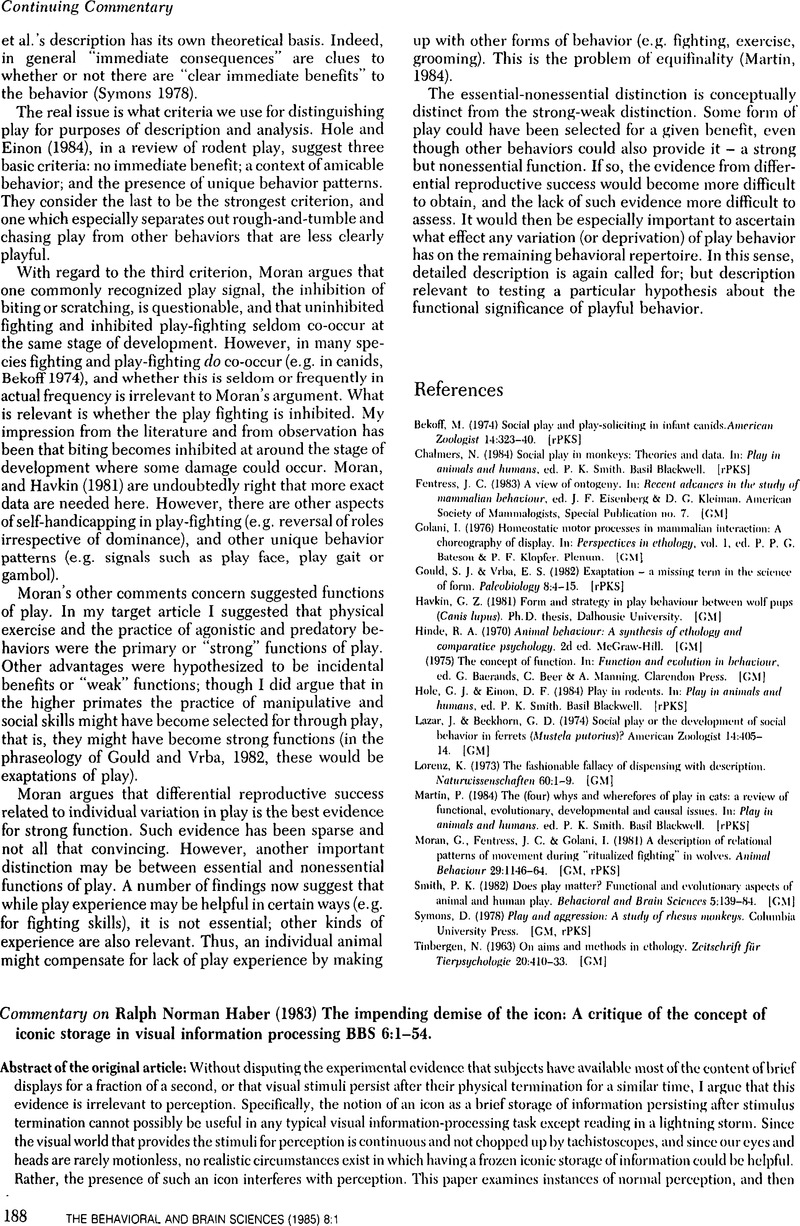No CrossRef data available.
Article contents
The icon as persistence of a brief stimulus – unnecessary and silly
Published online by Cambridge University Press: 04 February 2010
Abstract
An abstract is not available for this content so a preview has been provided. Please use the Get access link above for information on how to access this content.

- Type
- Author's Response
- Information
- Copyright
- Copyright © Cambridge University Press 1985
References
Breitmeyer, B. G. (1983) Icon as visual persistence: Alive and well. Behavioral and Brain Sciences 6:15–16. [PM]CrossRefGoogle Scholar
Breitmeyer, B. G.Kropfl, W. & Jnlesz, B. (1982) Tin-existence and role of retinotopie and spatiotopic forms of visual persistence. Acta Psychologica 52:175–96. [PM]CrossRefGoogle Scholar
Bridgeman, B. & Mayer, M. (1983) Iconic storage and saccadic eye movements Behavioral and Brain Sciences 6:16–17. [PM]CrossRefGoogle Scholar
Coltheart, M. (1980) Iconic memory and visible persistence. Perception and Psychophysics 27:183–228. [PM]CrossRefGoogle ScholarPubMed
Dick, A. O. (1974) Iconic memory and its relation to perceptual processing and other memory mechanisms. Perception and Psychophysics 16:575–96. [PM]CrossRefGoogle Scholar
Di Lollo, V. (1980) Temporal integration in visual memory. Journal of Experimental Psychology: General 109:75–97. [PM]CrossRefGoogle ScholarPubMed
Di Lollo, V. (1983) Icons no, iconic memory yes. Behavioral and Brain Sciences 6:19–20. [PM]CrossRefGoogle Scholar
Haber, R. N. (1983) The impending demise of the icon: A critique of the concept of iconic storage in visual information processing. Behavioral and Brain Sciences 6:1–54. [PM]CrossRefGoogle Scholar
Haber, R. N. & Hershenson, M. (1984) The psychology of visual perception. 2d ed. Holt, Rinehart and Winston. [rRNH]Google Scholar
Haber, R. N. & Standing, (1970) Direct measures of short-term visual storage. Quarterly Journal of Experimental Psychology 24:216–229. [rRNH]Google Scholar
Jonides, J. (1983) Reports of the icon's impending demise are premature. Behavioral and Brain Sciences 6:24–25. [PM]CrossRefGoogle Scholar
Jonides, J., Irwin, D. E. & Yantis, S. (1982) Integrating visual information from successive fixations. Science 215:192–94. [PM]CrossRefGoogle ScholarPubMed
Loftus, G. R. & Kallman, H. J. (1979) Encoding and use of detail information in picture recognition. Journal of Experimental Psychology: Human Learning and Memory 5:197–211. [PM]Google ScholarPubMed
Loftus, G. R., Johnson, C. A. & Shimamura, A. P. (1985) How much is an icon worth? Journal of Experimental Psychology: Human Perception and Performance 11:1–13. [rRNH, PM]Google ScholarPubMed
Long, G. M. (1980) Iconic memory: A review and critique of the study of short-term visual storage. Psychological Bulletin 88:785–820. [PM]CrossRefGoogle Scholar
Rayner, K. (1983) Icons, visual buffers, and eye movements. Behavioral and Brain Sciences 6:36–37. [PM]CrossRefGoogle Scholar
Sperling, G. (1960) The information available in brief visual presentations. Psychological Monographs 74, no. 11 (whole no. 498). [rRNH, PM]CrossRefGoogle Scholar
Sperling, G. (1983) Why we need iconic memory. Behavioral and Brain Sciences 6:37–39. [PM]CrossRefGoogle Scholar
Turvey, M. T. (1977) Contrasting orientations to the theory of visual information processing. Psychological Review 84:67–88. [PM]CrossRefGoogle Scholar


